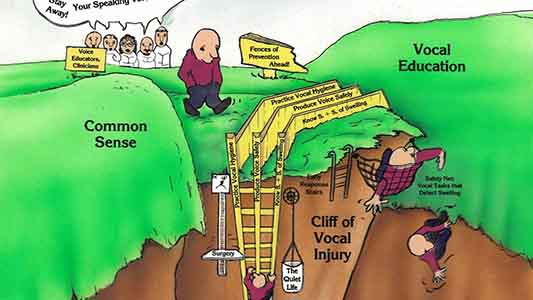Swelling Checks to Detect Vibratory (Overuse) Injury to the Surface Tissue (Mucosa) of the Vocal Cords
Robert W. Bastian, M.D. — Published: September 23, 2016
Definition
Vocal tasks (swelling checks) that detect acute or chronic vocal fold mucosal injury reliably; Secondarily, they can also detect gaps between otherwise normal folds.
Purpose /rationale
To provide persons with a way to detect mucosal trouble for themselves. We are in effect “taking all of the clothes off the mucosa.”
Who they are for
Anyone who uses the voice extensively or vigorously—particularly vocal overdoers.*
What they are not for
Voice training or performance.
When they should be done
When first learning the tasks, they should be done often until the concept of one’s mucosal ceiling pitch is understood (see below). Once both proficiency and ceiling are established, the tests require 20 seconds or less both morning and evening.
TEST I: “HAPPY BIRTHDAY”
- In your upper voice range, sing the first phrase of “Happy Birthday” as softly as you can, using a “boy soprano pianissimo.” Resist the temptation to “make it work” by getting louder!
- Repeat the phrase at progressively higher pitches.
- Verify carefully the pitch at which you falter (onset delays or air escape) or can’t go higher without getting louder. THIS IS YOUR MUCOSAL CEILING PITCH, FOR THIS TASK.
- If your mucosa is normal, the “soft voice” and “loud voice” ceilings pitch should be about the same.
- If your mucosa is abnormal, the “loud” ceiling pitch should be higher than the “soft.”
TEST II: STACCATO
- Sing again “boy soprano pianissimo” using the descending staccato figure so so so so so fa mi re do (5-5-5-5-5-4-3-2-1; e.g. G-G-G-G-G-F-E-D-C) Attack each note precisely in the middle of the continuum between an aspirated ho and a coupe de glotte. In other words, lightly, precisely, and with a little bounce.
- As for “Happy Birthday,” repeat at progressively higher pitches.
- Again carefully verify the pitch at which you experience onset delays or air escape or can’t go higher without getting louder. THIS IS YOUR MUCOSAL CEILING PITCH, FOR THIS TASK.
Daily Testing Is Crucial
After a few days of performing the swelling tests, you will discover your “mucosal ceiling pitch.” Above this point, the voice will falter—experience increased air escape and/or onset delays—unless you get louder.
If your mucosal ceiling pitch lowers, this may mean that you have developed swelling, or that known swellings have increased in size. You should then review your recent voice use to see if it has been excessive in any way. In this way, the swelling tests can serve as an early warning system and prompt you to relative voice rest until the mucosal ceiling pitch returns to its usual baseline.
Common Pitfalls
First, is the tendency to adjust how the voice is produced when it begins to falter. A singer will, for example, unconsciously get a bit louder or use a slight glottal attack to “make it work,” thereby reducing the sensitivity of the tasks. Another might be to perform them without a pitch reference at hand, so that the value of comparing with one’s known ceiling pitch is lost.
A third might be to become too easily “spooked” with any ceiling pitch change. Your ceiling pitch can vary by a semitone or two for no particular reason. Especially if review of your recent voice use provides no reason for a lowered ceiling, just wait until the next “check” in twelve hours. And the last pitfall is the tendency to “lose the habit!”
Common Questions about Swelling Checks
My mucosal ceiling pitch is higher when I do the staccato exercise than it is when I do “Happy Birthday.” What does that mean?
Though needing verification via careful laryngeal examination, this phenomenon suggests that a small gap between the folds, rather than swelling, is the problem.
My mucosal ceiling pitch is higher when I do the “Happy Birthday” exercise than it is when I do staccato. What does that mean?
Again needing verification, this phenomenon suggests a mucosal disturbance rather than a gap as the explanation.
I can figure out my mucosal ceiling pitch easily enough, but how do I know if it is normal?
This can be answered best at the outset by individuals who can compare your performance with that of hundreds of others to whom they have applied these tests (e.g. laryngologist, speech pathologist, voice teacher).
It is also helpful at the beginning to correlate your mucosal ceiling pitch with high quality visualization of the vocal folds.
What if my ceiling pitch isn’t normal as compared to others?
The swelling tests are nevertheless just as valuable! Here’s how: Suppose an individual’s initial mucosal ceiling pitch is abnormal because of small vocal nodules, but the person is happy with the voice’s capabilities. Here, the swelling tests can be monitored to help the individual prevent additional mucosal injury, by not allowing the ceiling pitch to descend any further. A different person whose initial ceiling pitch is abnormal might be unhappy with perceived limitations due to mucosal injury.
Now, ongoing use of the swelling tests can confirm the benefits of medical, behavioral (voice therapy) or, eventually, surgical treatments, because the ceiling pitch will rise with successful treatment. Furthermore, these tests can help to avoid recurrent injury.
What if I notice that my ceiling pitch is abnormal (lower) as compared to my usual?
First, consider recent voice use for the possibility that it was “too much.” If so, and/or if the ceiling pitch remains lowered on subsequent trials of the tests later in the day, “back off” by reducing voice use until the ceiling returns to your usual pitch, whether “normal” as compared to other persons or not.
Women: Some may find that the ceiling pitch lowers routinely during pre-menstrual days, but returns to normal in a few days.
Do I need to cancel everything until the ceiling pitch recovers?
This depends on the severity of the lowering of the ceiling pitch. Generally, however, careful strategy concerning amount and manner of voice use during this time will allow the mucosa to recover while you continue to work or perform.
If for some reason you are under contract and must perform, it becomes a matter of strategy:
- All the basics of hydration, etc.
- Rest as possible,
- Remove the throat-killer song from the gig
- Overarticulate
- Make optimal use of amplification.
In short, hobble through, knowing that you are swollen and making every possible choice to allow swelling to resolve. In a pinch such as when reviewers are attending, or it is a critical audition, a brief course of steroids, although we try very hard not to use them except in exceptional circumstances.
Are there common pitfalls in use of the swelling tests?
First and foremost, is the tendency to adjust how the voice is produced when the voice begins to falter. A singer will, for example, unconsciously get a bit louder or use a slight glottal attack to “make it work,” thereby reducing the sensitivity of the tasks.
Another might be to perform them without a pitch reference at hand, so that the value of comparing with one’s known “ceiling” pitch is lost. A third might be to become a bit too obsessive and easily “spooked” with any ceiling change. And finally, comes the tendency to “lose the habit!”
Do the checks work for people who haven’t developed their falsetto?
First and foremost, is the tendency to adjust how the voice is produced when the voice begins to falter. A singer will, for example, unconsciously get a bit louder or use a slight glottal attack to “make it work,” thereby reducing the sensitivity of the tasks.
Another might be to perform them without a pitch reference at hand, so that the value of comparing with one’s known “ceiling” pitch is lost. A third might be to become a bit too obsessive and easily “spooked” with any ceiling change. And finally, comes the tendency to “lose the habit!”
When doing the Staccato, is it ok to slow down as you go higher?
Sure, the key is very soft and light production, not speed of production.
What if you're having problems in the mid to low part of your range?
Swelling checks are mostly about assessing the mucosa (surface tissue) of the vocal cords. Injury of the mucosa almost always interferes with the high voice. If the problem is stability or control of low voice, we tend to think in other directions.
Will doing the checks aggravate a vocal nodule if you have one?
The answer is “no.” To expand: The tasks are not for vocal grooming nor for rehabilitation. Their purpose is solely to detect swelling. Since they are by design produced with a very tiny, quiet voice, and since it takes well under a minute to accomplish them, vocal cord swelling checks have no potential whatsoever to cause injury.
* Vocal overdoer: Defined as an individual with both of the following:
A high propensity to use the voice. Generally, “sixes and sevens” on a 7-point (maximum) intrinsic talkativeness scale.
A high extrinsic opportunity or invitation to use voice, based on family, social, vocational, and avocational considerations.

Vocal Cord Swelling Checks: A Simple Way to Detect the Early Signs of Vocal Injury
Vocal cord swelling checks can help prevent a chronic vocal injury. The swelling checks, which are a pair of short, simple vocal exercises, help you to monitor the health of your vocal cord mucosa and detect the presence of any possible swelling, which could be the beginning of a potentially more serious vocal cord injury.
By performing these checks twice a day every day, you can hopefully respond quickly to any warning signs and avoid the need for treatment down the road.

An Illustration of Vocal Cord Injury Prevention by Dr. Robert Bastian
When it comes to vocal cord injury, “It is better to build a fence at the top of a cliff than to park an ambulance at the bottom.” Prevention of injury is the point of Dr. Bastian’s tour of a cartoon he had drawn years ago.